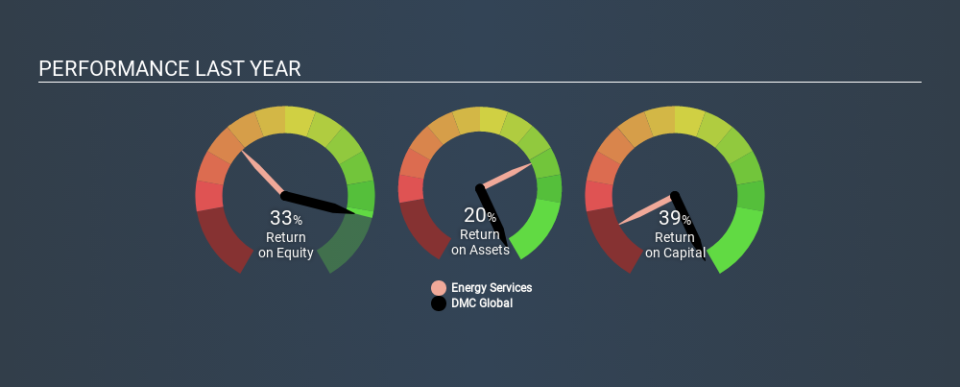What Can We Make Of DMC Global Inc.’s (NASDAQ:BOOM) High Return On Capital?

Today we'll look at DMC Global Inc. (NASDAQ:BOOM) and reflect on its potential as an investment. In particular, we'll consider its Return On Capital Employed (ROCE), as that can give us insight into how profitably the company is able to employ capital in its business.
First of all, we'll work out how to calculate ROCE. Then we'll compare its ROCE to similar companies. Then we'll determine how its current liabilities are affecting its ROCE.
Understanding Return On Capital Employed (ROCE)
ROCE is a metric for evaluating how much pre-tax income (in percentage terms) a company earns on the capital invested in its business. All else being equal, a better business will have a higher ROCE. In brief, it is a useful tool, but it is not without drawbacks. Renowned investment researcher Michael Mauboussin has suggested that a high ROCE can indicate that 'one dollar invested in the company generates value of more than one dollar'.
How Do You Calculate Return On Capital Employed?
Analysts use this formula to calculate return on capital employed:
Return on Capital Employed = Earnings Before Interest and Tax (EBIT) ÷ (Total Assets - Current Liabilities)
Or for DMC Global:
0.39 = US$82m ÷ (US$276m - US$64m) (Based on the trailing twelve months to September 2019.)
Therefore, DMC Global has an ROCE of 39%.
See our latest analysis for DMC Global
Is DMC Global's ROCE Good?
One way to assess ROCE is to compare similar companies. Using our data, we find that DMC Global's ROCE is meaningfully better than the 9.8% average in the Energy Services industry. We would consider this a positive, as it suggests it is using capital more effectively than other similar companies. Regardless of the industry comparison, in absolute terms, DMC Global's ROCE currently appears to be excellent.
DMC Global has an ROCE of 39%, but it didn't have an ROCE 3 years ago, since it was unprofitable. That suggests the business has returned to profitability. You can click on the image below to see (in greater detail) how DMC Global's past growth compares to other companies.
When considering ROCE, bear in mind that it reflects the past and does not necessarily predict the future. ROCE can be deceptive for cyclical businesses, as returns can look incredible in boom times, and terribly low in downturns. This is because ROCE only looks at one year, instead of considering returns across a whole cycle. Given the industry it operates in, DMC Global could be considered cyclical. Since the future is so important for investors, you should check out our free report on analyst forecasts for DMC Global.
What Are Current Liabilities, And How Do They Affect DMC Global's ROCE?
Liabilities, such as supplier bills and bank overdrafts, are referred to as current liabilities if they need to be paid within 12 months. Due to the way ROCE is calculated, a high level of current liabilities makes a company look as though it has less capital employed, and thus can (sometimes unfairly) boost the ROCE. To counteract this, we check if a company has high current liabilities, relative to its total assets.
DMC Global has total liabilities of US$64m and total assets of US$276m. Therefore its current liabilities are equivalent to approximately 23% of its total assets. A minimal amount of current liabilities limits the impact on ROCE.
Our Take On DMC Global's ROCE
Low current liabilities and high ROCE is a good combination, making DMC Global look quite interesting. DMC Global shapes up well under this analysis, but it is far from the only business delivering excellent numbers . You might also want to check this free collection of companies delivering excellent earnings growth.
If you are like me, then you will not want to miss this free list of growing companies that insiders are buying.
If you spot an error that warrants correction, please contact the editor at editorial-team@simplywallst.com. This article by Simply Wall St is general in nature. It does not constitute a recommendation to buy or sell any stock, and does not take account of your objectives, or your financial situation. Simply Wall St has no position in the stocks mentioned.
We aim to bring you long-term focused research analysis driven by fundamental data. Note that our analysis may not factor in the latest price-sensitive company announcements or qualitative material. Thank you for reading.

 Yahoo Finance
Yahoo Finance 
